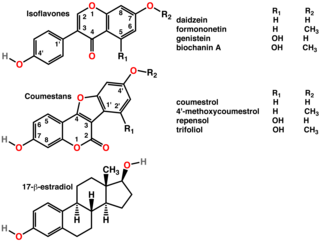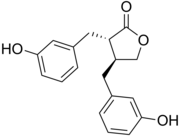A nutrient is a substance used by an organism to survive, grow, and reproduce. The requirement for dietary nutrient intake applies to animals, plants, fungi, and protists. Nutrients can be incorporated into cells for metabolic purposes or excreted by cells to create non-cellular structures, such as hair, scales, feathers, or exoskeletons. Some nutrients can be metabolically converted to smaller molecules in the process of releasing energy, such as for carbohydrates, lipids, proteins, and fermentation products, leading to end-products of water and carbon dioxide. All organisms require water. Essential nutrients for animals are the energy sources, some of the amino acids that are combined to create proteins, a subset of fatty acids, vitamins and certain minerals. Plants require more diverse minerals absorbed through roots, plus carbon dioxide and oxygen absorbed through leaves. Fungi live on dead or living organic matter and meet nutrient needs from their host.

Inulins are a group of naturally occurring polysaccharides produced by many types of plants, industrially most often extracted from chicory. The inulins belong to a class of dietary fibers known as fructans. Inulin is used by some plants as a means of storing energy and is typically found in roots or rhizomes. Most plants that synthesize and store inulin do not store other forms of carbohydrate such as starch. In the United States in 2018, the Food and Drug Administration approved inulin as a dietary fiber ingredient used to improve the nutritional value of manufactured food products. Using inulin to measure kidney function is the "gold standard" for comparison with other means of estimating glomerular filtration rate.

A phytoestrogen is a plant-derived xenoestrogen not generated within the endocrine system, but consumed by eating phytoestrogenic plants. Also called a "dietary estrogen", it is a diverse group of naturally occurring nonsteroidal plant compounds that, because of its structural similarity with estradiol (17-β-estradiol), have the ability to cause estrogenic and/or antiestrogenic effects. Phytoestrogens are not essential nutrients because their absence from the diet does not cause a disease, nor are they known to participate in any normal biological function.
![Secoisolariciresinol diglucoside Antioxidant[1] phytoestrogen present in flax, sunflower, sesame, and pumpkin seeds. In food, it can be found in commercial breads containing flaxseed](https://upload.wikimedia.org/wikipedia/commons/thumb/b/b2/Secoisolarisiresinol_diglucoside.svg/320px-Secoisolarisiresinol_diglucoside.svg.png)
Secoisolariciresinol diglucoside (SDG) is an antioxidant phytoestrogen present in flax, sunflower, sesame, and pumpkin seeds. In food, it can be found in commercial breads containing flaxseed. It is a precursor of mammal lignans which are produced in the colon from chemicals in foods.

Equol (4',7-isoflavandiol) is an isoflavandiol estrogen metabolized from daidzein, a type of isoflavone found in soybeans and other plant sources, by bacterial flora in the intestines. While endogenous estrogenic hormones such as estradiol are steroids, equol is a nonsteroidal estrogen. However, only about 30–50% of people have intestinal bacteria that make equol. Equol can exist in two enantiomeric forms, (S)-equol and (R)-equol. (S)-Equol preferentially binds estrogen receptor beta.
Prebiotics are compounds in food that induce the growth or activity of beneficial microorganisms such as bacteria and fungi. The most common example is in the gastrointestinal tract, where prebiotics can alter the composition of organisms in the gut microbiome.
The lignans are a large group of low molecular weight polyphenols found in plants, particularly seeds, whole grains, and vegetables. The name derives from the Latin word for "wood". Lignans are precursors to phytoestrogens. They may play a role as antifeedants in the defense of seeds and plants against herbivores.
Isoflavones are substituted derivatives of isoflavone, a type of naturally occurring isoflavonoids, many of which act as phytoestrogens in mammals. Isoflavones are produced almost exclusively by the members of the bean family, Fabaceae (Leguminosae).
Alkylresorcinols, also known as resorcinolic lipids, are phenolic lipids composed of long aliphatic chains and resorcinol-type phenolic rings.

Secoisolariciresinol is an organic compound. It is classified as a lignan, i.e., a type of phenylpropanoid. It is present in some cereals, e.g. rye, and together with matairesinol, has attracted much attention for its beneficial nutritional effects.

Podophyllotoxin (PPT) is the active ingredient in Podofilox, which is a medical cream that is used to treat genital warts and molluscum contagiosum. It is not recommended in HPV infections without external warts. It can be applied either by a healthcare provider or the person themselves.

Dietary factors are recognized as having a significant effect on the risk of cancers, with different dietary elements both increasing and reducing risk. Diet and obesity may be related to up to 30-35% of cancer deaths, while physical inactivity appears to be related to 7% risk of cancer occurrence. One review in 2011 suggested that total caloric intake influences cancer incidence and possibly progression.

Matairesinol is an organic compound. It is classified as a lignan, i.e., a type of phenylpropanoid. It is present in some cereals, e.g. rye, and together with Secoisolariciresinol, has attracted much attention for its beneficial nutritional effects.

Sesamin is a lignan isolated from the bark of Fagara plants and from sesame oil. It has been used as a dietary fat-reduction supplement, although no controlled studies on this application have been performed. Its major metabolite is enterolactone, which has an elimination half life of less than 6 hours. Sesamin and sesamolin are minor components of sesame oil, on average comprising only 0.14% of the oil by mass.

Lariciresinol is a lignan, i.e., a type of phenylpropanoids. It is the precursor to enterolignans by the action of gut microflora. Enterolignans are of interest because they are speculated to exhibit beneficial medicinal properties.

Enterolignans are organic compounds formed by the action of gut microflora on lignans. They are thus the products of the combined action of both plants and of the animal gut. Prominent enterolignans are enterodiol and enterolactone. Enterolignans are also called "mammalian lignans", although that term is self-contradictory since mammals do not produce lignans.
![Enterodiol Lignan formed by the action of intestinal bacteria on lignan precursors found in plants.[1]](https://upload.wikimedia.org/wikipedia/commons/thumb/e/eb/Enterodiol.png/320px-Enterodiol.png)
Enterodiol is an organic compound with the formula [HOC6H4CH2CH(CH2OH)]2.

Pinoresinol is a lignan found in Styrax sp. and in Forsythia suspensa. It is also found in the caterpillar of the cabbage butterfly, Pieris rapae where it serves as a defence against ants.

Hydroxymatairesinol (HMR) is a lignan found in Norway spruce. It is an enterolactone precursor with anticancer activities. In rats, HMR decreased the volume of induced tumours and stabilised established tumours, as well as preventing the development of new tumours. It has also shown anti-oxidant properties in vitro.



![Secoisolariciresinol diglucoside Antioxidant[1] phytoestrogen present in flax, sunflower, sesame, and pumpkin seeds. In food, it can be found in commercial breads containing flaxseed](https://upload.wikimedia.org/wikipedia/commons/thumb/b/b2/Secoisolarisiresinol_diglucoside.svg/320px-Secoisolarisiresinol_diglucoside.svg.png)








![Enterodiol Lignan formed by the action of intestinal bacteria on lignan precursors found in plants.[1]](https://upload.wikimedia.org/wikipedia/commons/thumb/e/eb/Enterodiol.png/320px-Enterodiol.png)

